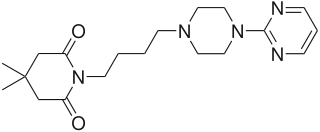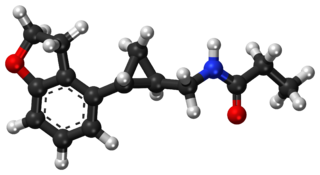Neurocrine Biosciences, Inc. is an American biopharmaceutical company founded in 1992. The company is headquartered in San Diego, California, and led by CEO Kevin Gorman. Neurocrine develops treatments for neurological and endocrine-related diseases and disorders. In 2017, the company's drug valbenazine (Ingrezza) was approved in the US to treat adults with tardive dyskinesia (TD).

Amifampridine is used as a drug, predominantly in the treatment of a number of rare muscle diseases. The free base form of the drug has been used to treat congenital myasthenic syndromes and Lambert–Eaton myasthenic syndrome (LEMS) through compassionate use programs since the 1990s and was recommended as a first line treatment for LEMS in 2006, using ad hoc forms of the drug, since there was no marketed form.

Gepirone, sold under the brand name Exxua, is a medication used for the treatment of major depressive disorder. It is taken orally.

Droxidopa, also known as L-threo-dihydroxyphenylserine (L-DOPS) and sold under the brand names Northera and Dops among others, is sympathomimetic medication which is used in the treatment of hypotension and for other indications. It is taken by mouth.

Tasimelteon, sold under the brand name Hetlioz, is a medication approved by the U.S. Food and Drug Administration (FDA) in January 2014, for the treatment of non-24-hour sleep–wake disorder. In June 2014, the European Medicines Agency (EMA) accepted an EU filing application for tasimelteon and in July 2015, the drug was approved in the European Union for the treatment of non-24-hour sleep-wake rhythm disorder in totally blind adults, but not in the case of non-24 in sighted people.

The National Organization for Rare Disorders (NORD) is a nonprofit organization, based in Connecticut, aiming to provide support for individuals with rare diseases by advocating and funding research, education, and networking among service providers. It was founded in 1983 by Abbey Meyers, along with individuals and rare diseases leaders of rare disease support groups, and it is a 501(c)(3) tax exempt organization.

F-15,599, also known as NLX-101, is a potent and selective 5-HT1A receptor full agonist. It displays functional selectivity by strongly activating 5-HT1A receptors in the postsynaptic prefrontal cortex while having little effect on somatodendritic autoreceptors in the raphe nucleus. As a result, it has been touted as a preferential postsynaptic 5-HT1A receptor agonist and has been investigated as a novel potential antidepressant.
An orexin receptor antagonist, or orexin antagonist, is a drug that inhibits the effect of orexin by acting as a receptor antagonist of one (selective orexin receptor antagonist or SORA) or both (dual orexin receptor antagonis or DORA) of the orexin receptors, OX1 and OX2. Medical applications include treatment of sleep disorders such as insomnia.

Mavoglurant (developmental code name AFQ-056) is an experimental drug candidate for the treatment of fragile X syndrome and other conditions. It exerts its effect as an antagonist of the metabotropic glutamate receptor 5 (mGluR5).

Rapastinel is a novel antidepressant that was under development by Allergan as an adjunctive therapy for the treatment of treatment-resistant depression. It is a centrally active, intravenously administered amidated tetrapeptide that acts as a novel and selective modulator of the NMDA receptor. The drug is a rapid-acting and long-lasting antidepressant as well as robust cognitive enhancer by virtue of its ability to enhance NMDA receptor-mediated signal transduction and synaptic plasticity.

Neurolixis is a biopharmaceutical company focused on novel drugs for the treatment of human central nervous system diseases.

ALTO-100, previously known as NSI-189, is a drug described as a hippocampal neurogenesis stimulant and indirect brain-derived neurotrophic factor (BDNF) modulator which is under development for the treatment of major depressive disorder (MDD), bipolar depression, and post-traumatic stress disorder (PTSD). There has also been interest in ALTO-100 for possible treatment of cognitive impairment and neurodegeneration. It is taken by mouth.

Basimglurant (INN) is a negative allosteric modulator of the mGlu5 receptor which is under development by Roche and Chugai Pharmaceutical for the treatment of treatment-resistant depression and fragile X syndrome. As of November 2016, it has undergone phase II clinical trials for both of these indications.
Catalyst Pharmaceuticals, Inc. is a biopharmaceutical company based in Coral Gables, Florida. The company is developing medicines for rare diseases, including the phosphate salt of amifampridine for the treatment of Lambert–Eaton myasthenic syndrome (LEMS). The drug is referred to under the trade name Firdapse, which was approved by the FDA for approved use in children 6 years and older with LEMS in addition to the prior approval for use in adults with LEMS on November 28, 2018. Firdapse commercially launched in January 2019.

Trofinetide, sold under the brand name Daybue, is a medication used for the treatment of Rett syndrome. It is taken by mouth.

Levoketoconazole, sold under the brand name Recorlev, is a steroidogenesis inhibitor that is used for the treatment of Cushing's syndrome. Levoketoconazole was approved for medical use in the United States in December 2021.

Zelquistinel is an orally active small-molecule NMDA receptor modulator which is under development for the treatment of major depressive disorder (MDD) by Gate Neurosciences, and previously by Allergan.

Ultragenyx Pharmaceutical Inc. is an American biopharmaceutical company involved in the research and development of novel products for treatment of rare and ultra-rare genetic diseases for which there are typically no approved treatments and high unmet medical need. The company works with multiple drug modalities including biologics, small molecule, gene therapies, and ASO and mRNAs in the disease categories of bone, endocrine, metabolic, muscle and CNS diseases.

ACT-539313 is an orexin antagonist medication which is under development for the treatment of binge eating disorder and was previously under development for the treatment of anxiety disorders. It is an orally active small-molecule compound with an elimination half-life of 3.3 to 6.5 hours and acts as a selective orexin OX1 receptor antagonist (1-SORA). As of May 2022, the drug is in phase 2 clinical trials for binge eating disorder. Following negative efficacy results of a phase 2 trial of ACT-539313 for binge eating disorder, Idorsia (the developer of ACT-539313) signaled in May 2022 that it would not pursue further development of the drug for this indication.

CPP-115 is an experimental drug being studied for the treatment of various neurological and psychiatric disorders including cocaine addiction, infantile spasms, and Tourette syndrome.

















